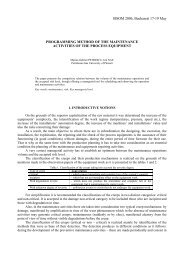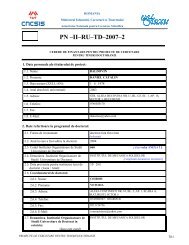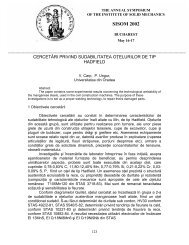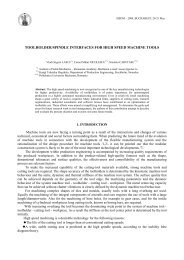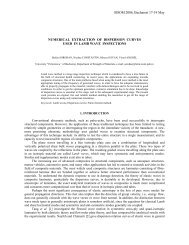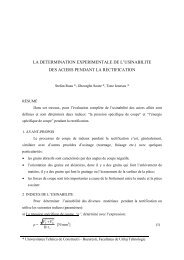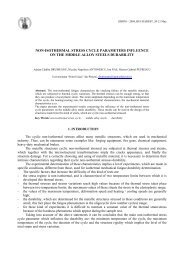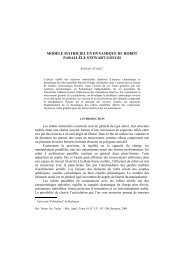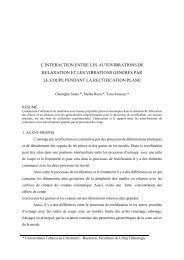theoretical and experimental contributions concerning the projection ...
theoretical and experimental contributions concerning the projection ...
theoretical and experimental contributions concerning the projection ...
You also want an ePaper? Increase the reach of your titles
YUMPU automatically turns print PDFs into web optimized ePapers that Google loves.
SISOM 2007 <strong>and</strong> Homagial Session of <strong>the</strong> Commission of Acoustics, Bucharest 29-31 May<br />
THEORETICAL AND EXPERIMENTAL CONTRIBUTIONS CONCERNING THE<br />
PROJECTION OF SHAPED ULTRASOUND ENERGETIC CONCENTRATOR<br />
PROFILED TYPE USED FOR THE ULTRASOUND WELDING OF MIXED MATERIALS<br />
Cornelia LUCHIAN, Gheorghe AMZA, Florea DUMITRACHE<br />
University “Politehnica” of bucharest, e-mail: cornelia_lucky@yahoo.com<br />
In <strong>the</strong> paper it is being presented <strong>the</strong> results obtained in <strong>the</strong> case of bell-type profiled<br />
concentratrors used for <strong>the</strong> ultrasound welding of compound materials used in <strong>the</strong> automobile<br />
construction.<br />
Keywords: ultrasound, acoustic concentrators<br />
1. THEORETICAL CONTRIBUTIONS<br />
The ultrasound energetic concentrators must be calculated so that <strong>the</strong>y should work with each<br />
component <strong>and</strong> fulfill <strong>the</strong> following functions: to conduct ultrasound energy from <strong>the</strong> transductor to <strong>the</strong> place<br />
where <strong>the</strong> welding takes place, to concentrate <strong>and</strong> easy <strong>the</strong> ultrasound energy in <strong>the</strong> area, to increase <strong>the</strong><br />
particle’s speed value watching <strong>the</strong> enlargement of <strong>the</strong> work tool <strong>and</strong> at <strong>the</strong> same time <strong>the</strong> acoustic intensity,<br />
through <strong>the</strong>ir form <strong>the</strong>y lead to a very diverse scale of welded constructions <strong>and</strong> to obtaining different kinds<br />
of acoustic waves ( longitudinal, transversal, of surface, of torsion, radial or combinations), to allow<br />
sustaining or fixing <strong>the</strong> entire acoustic system within <strong>the</strong> whole welding installation in <strong>the</strong> crucial plans.<br />
To work with good efficiency <strong>the</strong> concentrator must be tuned with an approximation of a few<br />
frequencies with which <strong>the</strong> ultrasound transductor is calculated, so <strong>the</strong> entire moving system must work in<br />
terms of resonance so that <strong>the</strong> particle's speed amplitude at <strong>the</strong> top of <strong>the</strong> sonotrode was even bigger <strong>and</strong>, so,<br />
also <strong>the</strong> acoustic intensity [1], [2].<br />
For <strong>the</strong> calculus of acoustic transformers it can be applied <strong>the</strong> <strong>the</strong>ory of elastic waves spreading<br />
through variable section rods, being taken into consideration <strong>the</strong> unmatched vibrations case, where <strong>the</strong><br />
waves’ equation has <strong>the</strong> following expression:<br />
2<br />
∂ Φ<br />
− c<br />
2<br />
∂t<br />
2<br />
2<br />
∂Φ∂<br />
2 ∂ Φ<br />
(ln S<br />
x<br />
) − c = 0<br />
( 1 )<br />
2<br />
∂x∂x<br />
∂x<br />
in which: Φ is <strong>the</strong> speed potential; Sx – <strong>the</strong> surface area of <strong>the</strong> bar’s section at a distance x from its<br />
origin; c – <strong>the</strong> speed of <strong>the</strong> acoustic waves spreading waves through <strong>the</strong> material from which <strong>the</strong> rod is made<br />
of.<br />
It is obvious that <strong>the</strong> waves’ equation will take different shapes related to <strong>the</strong> variation type of <strong>the</strong><br />
rod’s section in length: linear, in scales, exponential, catenarial, <strong>the</strong> different order (parabola) <strong>and</strong><br />
combinations of <strong>the</strong> forms mentioned above.<br />
In case of acoustic transformers that have <strong>the</strong> following section’s form:<br />
−αx<br />
S S e<br />
( 2 )<br />
x<br />
= 0<br />
where α is <strong>the</strong> characteristic coefficient of <strong>the</strong> section’s variation type, <strong>the</strong> equation (1) becomes:<br />
2<br />
2<br />
∂ Φ ∂Φ 1 ∂ Φ<br />
−α = .<br />
( 3 )<br />
2<br />
2 2<br />
∂x<br />
∂x<br />
c ∂t
Considering as <strong>the</strong> equation’s (3) general solution is:<br />
j(<br />
ω t+γx)<br />
( t,<br />
x) = Ce<br />
Φ ( 4 )<br />
<strong>and</strong> by replacing in <strong>the</strong> equation Φ(t,x) <strong>and</strong> its derivatives you obtain <strong>the</strong> general solution of <strong>the</strong> equation (3):<br />
Φ<br />
⎛<br />
⎞<br />
α<br />
2 α<br />
x<br />
2 2<br />
jx k −<br />
2 jx k α<br />
jωt<br />
t x = e<br />
⎜ − − / 4<br />
4<br />
( , ) Ae + Be<br />
⎟<br />
e<br />
( 5 )<br />
⎜<br />
⎝<br />
where k = ω / c, <strong>and</strong> A <strong>and</strong> B are two invariables that can be determined from <strong>the</strong> limit-conditions.<br />
From (5) we realize that <strong>the</strong>re are two waves in <strong>the</strong> rod: <strong>the</strong> first one spreads from <strong>the</strong> bottom to <strong>the</strong><br />
top <strong>and</strong> <strong>the</strong> o<strong>the</strong>r one spreads from <strong>the</strong> top to <strong>the</strong> bottom coming from <strong>the</strong> reflection (regressive wave).<br />
If you know <strong>the</strong> speeds potential you can determine <strong>the</strong> acoustic pressure’s expression in a point of<br />
distance x from <strong>the</strong> origin with <strong>the</strong> following relation:<br />
p<br />
x<br />
2<br />
⎟<br />
⎠<br />
α ω<br />
ω<br />
∂Φ<br />
x ⎛ − j x j x ⎞<br />
2 c<br />
c jωt<br />
ρ jρωe<br />
⎜ '<br />
'<br />
= − = − Ae Be ⎟e<br />
t<br />
+<br />
( 6 )<br />
∂<br />
⎝<br />
⎠<br />
The VX particle’s speed expression can be determined in <strong>the</strong> same way with <strong>the</strong> expression:<br />
Where<br />
v<br />
x<br />
=<br />
c’ = c/<br />
∂Φ<br />
∂x<br />
= e<br />
α<br />
x<br />
2<br />
⎡ ⎛α<br />
ω ⎞<br />
⎢A⎜<br />
− j ⎟e<br />
⎣ ⎝ 2 c'<br />
⎠<br />
1 ω<br />
ω<br />
− j x<br />
c'<br />
⎛α<br />
+ B⎜<br />
+<br />
⎝ 2<br />
ω ⎞<br />
j ⎟e<br />
c'<br />
⎠<br />
ω<br />
j x<br />
c'<br />
⎤<br />
⎥<br />
⎦<br />
( 7 )<br />
2 2 2<br />
− α c / 4<br />
( 8 )<br />
<strong>and</strong> ρ – <strong>the</strong> density of <strong>the</strong> material <strong>the</strong> rod is made from.<br />
For <strong>the</strong> use of acoustic transformers it is necessary that we know what is <strong>the</strong> particle’s speed at <strong>the</strong><br />
initial <strong>and</strong> final sections.<br />
⎡ ⎛α<br />
ω ⎞ ⎛α<br />
ω ⎞⎤<br />
jωt<br />
x⇒<br />
0 → v = ⎢A⎜<br />
− j ⎟ + B⎜<br />
+ j ⎟ e<br />
0<br />
c<br />
c<br />
⎥<br />
⎣ ⎝ 2 ' ⎠ ⎝ 2 ' ⎠⎦<br />
( 9 )<br />
x⇒<br />
L → v<br />
L<br />
= e<br />
α<br />
L<br />
2<br />
⎡ ⎛α<br />
⎢A⎜<br />
−<br />
⎣ ⎝ 2<br />
ω ⎞ ⎛α<br />
j ⎟ + B⎜<br />
+<br />
c'<br />
⎠ ⎝ 2<br />
ω ⎞<br />
j ⎟e<br />
c'<br />
⎠<br />
ω<br />
j L<br />
c'<br />
⎤<br />
⎥e<br />
⎦<br />
jωt<br />
( 10)<br />
In most cases it is preferable that <strong>the</strong> length of <strong>the</strong> acoustic transformers L was equal with a whole<br />
number of wave length values, meaning:<br />
λ' nc'<br />
L = n =<br />
2 2 f<br />
A very important measure that characterizes <strong>the</strong> acoustic transformer is <strong>the</strong> N amplifying coefficient,<br />
defined as <strong>the</strong> particle’s speed on <strong>the</strong> final section against <strong>the</strong> particle’s speed on <strong>the</strong> initial section.<br />
( 11 )<br />
N<br />
v<br />
=<br />
v<br />
L<br />
0<br />
=<br />
α<br />
L<br />
n 2<br />
( −1)<br />
=<br />
e<br />
S<br />
S<br />
0<br />
f<br />
( 12 )<br />
If you know <strong>the</strong> N amplifying coefficient (as an initial condition for <strong>the</strong> transformer) you can<br />
determine that coefficient α with <strong>the</strong> following relation:<br />
385
2ln N<br />
α = ( 13 )<br />
L<br />
The most important element of <strong>the</strong> transformer remains, still, <strong>the</strong> length - L – upon which must be<br />
applied certain corrections depending on <strong>the</strong> variation type of <strong>the</strong> sections <strong>and</strong> <strong>the</strong> way in which <strong>the</strong> elements<br />
are connected. In addition, using <strong>the</strong> relations (10), (12) <strong>and</strong> (13) you can determine <strong>the</strong> length of <strong>the</strong><br />
acoustic transformer with <strong>the</strong> following expression:<br />
in which:<br />
f e<br />
nc<br />
L = . 2<br />
f e<br />
1 π<br />
2<br />
+ _(ln N / n )<br />
( 14 )<br />
is <strong>the</strong> calculus frequency in Hz, c – <strong>the</strong> longitudinal waves’ spreading in a material from which<br />
<strong>the</strong> rod is made in m/s, n – full number.<br />
Ano<strong>the</strong>r important parameter for <strong>the</strong> calculus of a moving system, but also for <strong>the</strong> concentrator is <strong>the</strong><br />
knowing of <strong>the</strong> nodal plans, necessary for fixing <strong>the</strong> entire moving system in <strong>the</strong> installation that he is part<br />
of. For determining <strong>the</strong> positions of <strong>the</strong> nodal plans it is imposed <strong>the</strong> canceling of <strong>the</strong> Vx = 0 speed, <strong>and</strong> for<br />
<strong>the</strong> relation (7) you obtain:<br />
⎡α<br />
⎛ ω ⎞ ω ⎛ ω ⎞⎤<br />
(A+B) ⎢ cos⎜<br />
x⎟<br />
− sin⎜<br />
x⎟<br />
= 0<br />
2 ' ' '<br />
⎥<br />
⎣ ⎝ c ⎠ c ⎝ c ⎠⎦<br />
Table 1: The values of <strong>the</strong> ‘N’ multiplication coefficient<br />
Crr. The section’s form <strong>and</strong> <strong>the</strong> concentrator’s type<br />
Nr.<br />
The multiplication<br />
coefficient in functioning<br />
estate<br />
Observations <strong>and</strong><br />
notes<br />
0 1 2 3<br />
1<br />
( 15 )<br />
N<br />
=<br />
D<br />
0<br />
D f<br />
cylindrical,<br />
exponential<br />
2<br />
N<br />
=<br />
a<br />
0 .<br />
b<br />
0<br />
a f<br />
b f<br />
rectangular,<br />
exponential<br />
3<br />
N<br />
=<br />
D<br />
2<br />
D<br />
− d<br />
2<br />
circular, exponential<br />
4<br />
N r<br />
=<br />
cos Kl<br />
N<br />
cos Kl<br />
1<br />
2<br />
cylindrical,<br />
exponential<br />
K =<br />
ω<br />
c<br />
l = 0 3<br />
386
that results in:<br />
c'<br />
⎛α<br />
c'<br />
⎞<br />
x nodal<br />
= arctg⎜<br />
+ n'<br />
π ⎟<br />
( 16 )<br />
ω ⎝ 2 ω ⎠<br />
Taking in consideration that L is a full number with semi-lengths of waves, expression (16) becomes:<br />
L ⎛ 1 ⎞<br />
x nodal<br />
= arctg⎜<br />
ln N + n'<br />
π ⎟<br />
( 17 )<br />
nπ<br />
⎝ nπ<br />
⎠<br />
in which n <strong>and</strong> n’ are full numbers, n’ = 0 for <strong>the</strong> first nodal point <strong>and</strong> n’ = 1 for <strong>the</strong> second nodal point etc.<br />
In table 1 are given <strong>the</strong> values for <strong>the</strong> ‘N’ multiplication coefficient for some types of sections, in<br />
table 2 are indicated <strong>the</strong> parameters of some types of acoustic transformers [2], [5] .<br />
Table 2: The parameters of some types of acoustic transformers<br />
The type of<br />
<strong>the</strong><br />
concentrator<br />
The<br />
section’s<br />
variation<br />
law<br />
D<br />
x<br />
=<br />
N =<br />
D<br />
D<br />
D<br />
0<br />
f<br />
0<br />
e<br />
α<br />
− x<br />
2<br />
ω ln N<br />
α =<br />
c π +<br />
( ln N ) 2<br />
D x<br />
= D 0<br />
for<br />
x<br />
D f<br />
0 ≤ x ≤<br />
1<br />
2<br />
D = for 1≤ x ≤1<br />
D<br />
x<br />
α =<br />
=<br />
ω<br />
c<br />
D<br />
0<br />
e<br />
α<br />
− x 4<br />
The<br />
<strong><strong>the</strong>oretical</strong><br />
coefficient<br />
of<br />
amplifying<br />
of <strong>the</strong><br />
amplitude<br />
The length<br />
of <strong>the</strong><br />
concentrators<br />
The nodal<br />
point’s<br />
coordinates<br />
(nodal x)<br />
N<br />
D<br />
D<br />
r<br />
= 0 =<br />
r<br />
N<br />
2<br />
N<br />
r<br />
2<br />
⎛ D ⎞<br />
= = N<br />
⎜<br />
D ⎟<br />
⎝ f ⎠<br />
0 2<br />
c ⎛ln<br />
N ⎞<br />
L = 1+ ⎜ ⎟<br />
L<br />
2 f ⎝ π ⎠ f<br />
x<br />
nod<br />
L ln N<br />
1 c<br />
= arctg<br />
x<br />
π π<br />
nod = =<br />
2 4f<br />
Nr<br />
= 1+<br />
4lnN<br />
= λ c<br />
2 =<br />
λ ⎡ 2 ln N<br />
L = ⎢ +<br />
1<br />
2 ⎣ π 2<br />
2<br />
λ arctg(2 ln N )<br />
+ ⋅<br />
2 π<br />
x<br />
nod<br />
L 2ln N<br />
arctg<br />
⎤<br />
⎥ +<br />
⎦<br />
= π π<br />
387
2. EXPERIMENTAL CONTRIBUTIONS<br />
Using <strong>the</strong> methodic <strong>projection</strong> of <strong>the</strong> transductors <strong>and</strong> ultra-acoustic concentrators it has<br />
been created <strong>the</strong> ultrasound concentrator <strong>and</strong> transductor presented in <strong>the</strong> figures from 1 to 7 [3], [4].<br />
Fig. 1: <strong>the</strong> geometrical dimensions of <strong>the</strong> ultra-acoustic system with a bell-type concentrator used for experiments: 1 –<br />
piezoceramic group; 2 – movement amplifier; 3 – bell-type concentrator;<br />
Fig. 2: <strong>the</strong> geometrical dimensions of <strong>the</strong> ultra-acoustic system with a prismatic-type concentrator used for experiments: 1 –<br />
piezoceramic group; 2 – movement amplifier; 3 – prismatic-type concentrator;<br />
Fig.3: general view on <strong>the</strong> ultra-acoustic system with a bell-type concentrator:<br />
1 – piezoceramic group; 2 – movement amplifier; 3 - concentrator<br />
388
Fig 4: general view on <strong>the</strong> ultra-acoustic system with a a prismatic-type concentrator:<br />
1 - piezoceramic group; 2 - movement amplifier; 3 – concentrator<br />
Fig. 5: The geometrical dimensions of <strong>the</strong> movement amplifier<br />
Fig. 6: <strong>the</strong> geometrical dimensions of <strong>the</strong> bell-type acoustic concentrator<br />
Fig. 7: <strong>the</strong> geometrical dimensions of <strong>the</strong> prismatic-type acoustic concentrator<br />
389
3. CONCLUSIONS<br />
The acoustic intensity obtained through an ultrasound transductor has a limited value determined by <strong>the</strong><br />
nature of <strong>the</strong> material that it is made of, this is why it is necessary to create in a relatively reduced volume<br />
much bigger densities of acoustic energy which should allow <strong>the</strong> ultrasound welding of composed materials.<br />
The ultrasound energy concentrators which represent <strong>the</strong> ultra-acoustic brain of <strong>the</strong> system must be<br />
calculated in such way that <strong>the</strong>y should fulfill <strong>the</strong> following functions: <strong>the</strong>y conduct <strong>the</strong> ultrasound energy<br />
from <strong>the</strong> transductor to <strong>the</strong> place of <strong>the</strong> welding; <strong>the</strong>y concentrate <strong>and</strong> focus <strong>the</strong> ultrasound energy in <strong>the</strong><br />
combining zone; <strong>the</strong>y amplify <strong>the</strong> particle’s speed value by increasing <strong>the</strong> amplitude of <strong>the</strong> work tool <strong>and</strong><br />
also <strong>the</strong> acoustic intensity; through <strong>the</strong>ir shape <strong>the</strong>y allow a very diverse scale of welded combinations <strong>and</strong><br />
<strong>the</strong> obtaining of different types of acoustic waves (longitudinal, transversal, of surface, of torsion, radial or<br />
combinations); <strong>the</strong>y allow <strong>the</strong> sustaining or fixing of <strong>the</strong> entire acoustic system in <strong>the</strong> whole of <strong>the</strong><br />
installation that must be welded in <strong>the</strong> nodal plans.<br />
To work with better efficiency, <strong>the</strong> ultrasound system should work in terms of resonance so that <strong>the</strong><br />
particle’s speed amplitude <strong>and</strong> so <strong>the</strong> acoustic intensity are as big as in <strong>the</strong> welding zone.<br />
For <strong>the</strong> calculus of ultrasound energy concentrators it is being applied <strong>the</strong> elastic waves spreading<br />
<strong>the</strong>ory in rods of variable sections while <strong>the</strong> primary calculus elements are: <strong>the</strong> concentrator’s length, <strong>the</strong><br />
multiplication coefficient, <strong>the</strong> coefficient of <strong>the</strong> variation section, <strong>the</strong> diameter in each section, <strong>the</strong> nodal<br />
points’ coordinates, <strong>the</strong> weight <strong>and</strong> <strong>the</strong> relative disagreement of frequency.<br />
For a quick <strong>projection</strong> of <strong>the</strong> concentrators <strong>the</strong>re has been build calculus nomograms, <strong>the</strong> problem of<br />
executing <strong>the</strong>m through different methods remaining open. The functioning of <strong>the</strong> concentrators at <strong>the</strong><br />
established efficiency <strong>and</strong> <strong>the</strong>ir fiability in functioning depend on <strong>the</strong> way <strong>the</strong>y are executed, on <strong>the</strong> surfaces<br />
qualities, on <strong>the</strong> dimensional precision <strong>and</strong> on <strong>the</strong> nature of <strong>the</strong> material that <strong>the</strong>y are made of. The surface of<br />
<strong>the</strong> concentrators must have a roughness Ra




